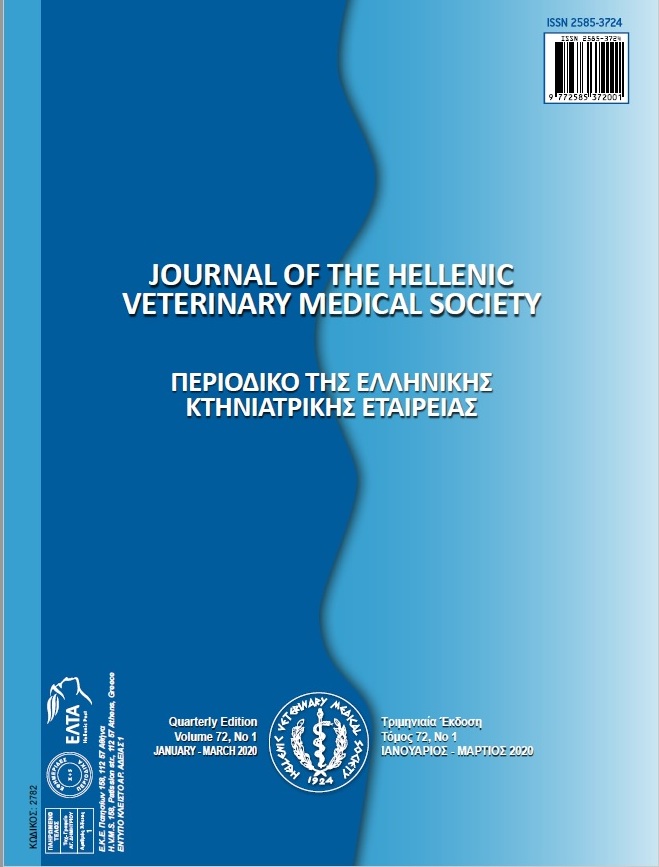Occurrence and molecular characterization of Salmonella Typhimurium and Salmonella Enteritidis isolates from contaminated food samples from Palestine
Περίληψη
Salmonella is one of the most frequently isolated foodborne pathogens. It is of major public health concern worldwide. Poultry meat and eggs represent an important source of Salmonellae organism for consumer health. This study aimed to evaluate the occurrence of Salmonella enterica serotype Typhimurium and Enteritidis using multiplex PCR (mPCR) among isolates collected from the local market and to assess genetic relationships between isolates of S. Typhimurium, which was the only serotype isolated from the tested food samples. This was done using virulence factors profiling and fingerprint profiling by random amplified polymorphic DNA (RAPD-PCR) and repetitive sequence PCR (REP-PCR) using enterobacterial repetitive intergenic consensus (ERIC-PCR) and interspersed repetitive DNA sequence BOXAIR-PCR.
The overall occurrence percentage of S. Typhimurium and S. Enteritidis out of 51 isolates was 54.9% and 0.0%, respectively. Only 13 out of 17 virulence genes were detected in these isolates. The occurrence of the detected virulence genes among these isolates was 100%, 50.0%,46.4%, 39.3%, 35.7%, 35.7%, 32.1%, 25.0%, 25.0%, 17.6%, 14.3%, 14.3%, 3.6% for invA, sopB, prgH, sitC, pefA, tolC, cdtB, msgA, sifA, iroN, spiA, ipfC and pagC, respectively. The remaining virulence genes were absent in all of the isolates. Based on the combination of the presence and absence of virulence genes, eight profiles were detected among these isolates, the most common genetic profile was V5 (each 32.1%). Based on this genetic profile at cut-off point 96.0%, both ERIC and BOX primers allowed for discrimination into 4 and 6 clusters or clones of 16 S. Typhimurium isolates, respectively. Results of PCR typing methods showed that, three strains clustered together using both ERIC-PCR and BOX-PCR typing methods and they had the same virulotype (V1), while other four strains also clustered together by both typing methods and had the same virulotype (V8).
Contamination of food with Salmonellae especially with S. Typhimurium was high and indicated a bad microbiological quality of food. This emphasizes the need for rigorous public health and food safety methods to lower the human health hazard and risk associated with Salmonellae infection.
Λεπτομέρειες άρθρου
- Πώς να δημιουργήσετε Αναφορές
-
Adwan, G., Abuseir, S., Khreishi , O., Hussein, A., Khraim, N., & Abed Al-Daym , M. (2023). Occurrence and molecular characterization of Salmonella Typhimurium and Salmonella Enteritidis isolates from contaminated food samples from Palestine. Περιοδικό της Ελληνικής Κτηνιατρικής Εταιρείας, 74(3), 6201–6211. https://doi.org/10.12681/jhvms.31088
- Τεύχος
- Τόμ. 74 Αρ. 3 (2023)
- Ενότητα
- Research Articles

Αυτή η εργασία είναι αδειοδοτημένη υπό το CC Αναφορά Δημιουργού – Μη Εμπορική Χρήση 4.0.
Οι συγγραφείς των άρθρων που δημοσιεύονται στο περιοδικό διατηρούν τα δικαιώματα πνευματικής ιδιοκτησίας επί των άρθρων τους, δίνοντας στο περιοδικό το δικαίωμα της πρώτης δημοσίευσης.
Άρθρα που δημοσιεύονται στο περιοδικό διατίθενται με άδεια Creative Commons 4.0 Non Commercial και σύμφωνα με την άδεια μπορούν να χρησιμοποιούνται ελεύθερα, με αναφορά στο/στη συγγραφέα και στην πρώτη δημοσίευση για μη κερδοσκοπικούς σκοπούς.
Οι συγγραφείς μπορούν να καταθέσουν το άρθρο σε ιδρυματικό ή άλλο αποθετήριο ή/και να το δημοσιεύσουν σε άλλη έκδοση, με υποχρεωτική την αναφορά πρώτης δημοσίευσης στο J Hellenic Vet Med Soc
Οι συγγραφείς ενθαρρύνονται να καταθέσουν σε αποθετήριο ή να δημοσιεύσουν την εργασία τους στο διαδίκτυο πριν ή κατά τη διαδικασία υποβολής και αξιολόγησής της.




